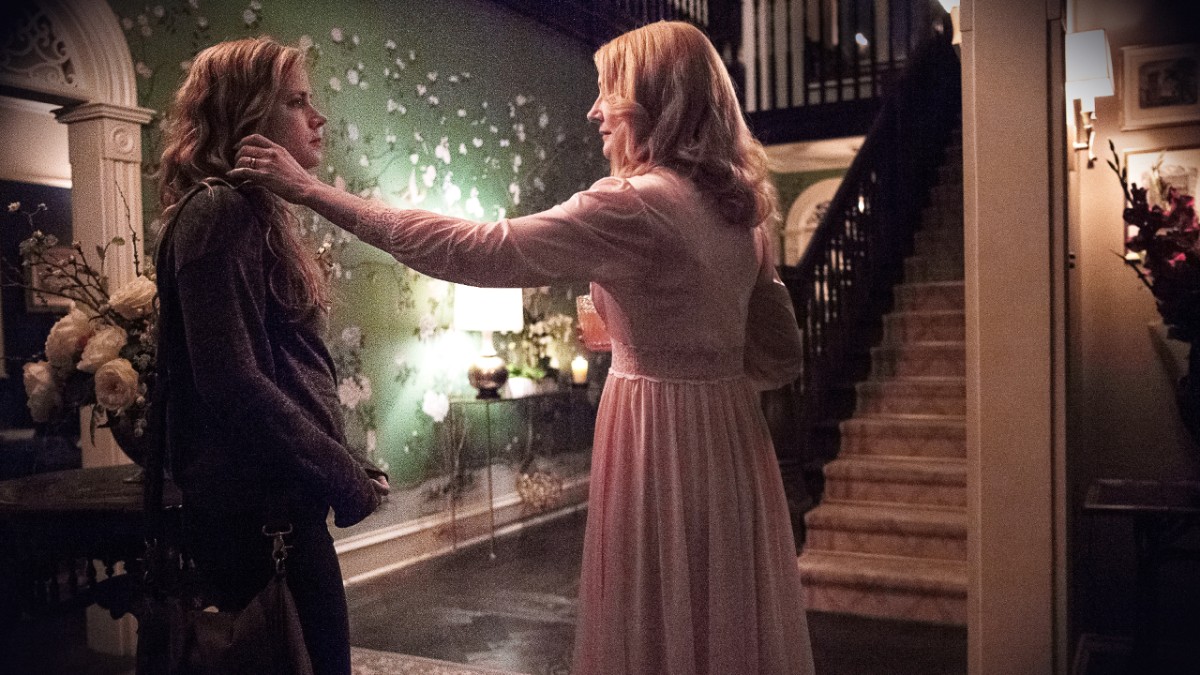Four episodes into its eight-episode season, HBO’s Sharp Objects seems to be about two mysteries: the murders of teenage girls in Wind Gap, Missouri, and the trauma investigative reporter Camille (Amy Adams) suffered there as a teenager, which resurfaces when she’s assigned to return home to report on the murders by her St. Louis newspaper editor.
Like any good mystery, we’ve been given clues about both the murders and Camille’s trauma, but key information remains missing. Camille’s trauma seems to be linked to the death of her younger sister Marian when both were teens, although it’s unclear exactly how Marian died or if Camille or her overbearing mother Adora is somehow partly culpable. The mystery of the murdered teens is more opaque at this halfway point, but numerous possible suspects have been floated as potential killers.

I must admit I’m more interested in the mystery of Camille’s trauma than I am in the mystery of the murdered teens. The latter is well-worn genre territory, and while it’s a serviceable story, Sharp Objects doesn’t seem to be bringing much of anything new to the table, trading in familiar genre conventions such as gruesome corpses, a clash between small town and big city law enforcement, suspiciously-behaving bereaved families, an investigative reporter prodding at the edges of the mystery, and so on.
So far so good, but this show thrives most when it focuses on Camille’s trauma, showing how her and other characters’ pasts affect their lives in the present, often through deft stylistic touches. For example, when Camille remembers traumatic moments from her past, we’re often treated to very brief flashbacks of emblematic images. When we first see them, they often lack context, but over the course of the first four episodes, we gradually learn what some of them mean. These brief cutaways do a good job of conveying how Camille carries her trauma with her at all times, sneaking up on her in unexpected moments.
Sharp Objects has other ways of conveying how past traumas creep into the present aside from flashbacks. Previously, Camille dealt with her trauma by cutting words into her skin – her body is covered in scars externalizing her feelings. She’s since replaced cutting with drinking, but psychologically telling words often appear on other surfaces: etched into a tabletop (“bad”), rubbed into the grime on her car (“dirty”), or even replacing a freeway sign (“spiteful”). Like the flashbacks, the words are another manifestation of what Camille is thinking or feeling at a given moment.

We’re also treated to moments of Camille’s subjectivity when she frequently spies her deceased sister Marian out of the corner of her eye, as if Marian were a ghost haunting Camille’s childhood home. Sometimes Marian’s ghost is replaced with Alice, a surrogate sister with whom Camille bonded while voluntarily staying in a psychiatric ward as an adult, but who committed suicide in an episode three flashback. These subjective moments, be they flashbacks, words, or ghostly invasions, all add up to a compelling portrayal of the lingering trauma Camille has suffered while also acting as clues about its precise nature.
Possibly the deftest of these depictions of trauma occurs in episode four: Camille’s past is interwoven with the present when Amy Adams (who plays Camille as an adult) is briefly replaced by the actress who plays Camille as a teenager (Sophia Lillis). Camille washes her face in the sink as an adult, but when she stands upright and looks in the mirror, her teenaged face stares back at her.
This scene comes on the heels of Camille watching her mother Adora and her teenaged half-sister Amma sharing an affectionate moment, and is followed by a flashback where Adora is too overcome with Marian-related grief to attend to teenaged Camille. Camille and Adora have a fractious relationship both in the present and in the past, but this scene’s replacement of adult Camille with teenaged Camille, coupled with the flashback, leaves the nature of Camille’s feelings toward her family slightly ambiguous.
Perhaps Camille feels regret over not being able to provide comfort to her mother the way Amma can. Or perhaps Camille is jealous of how close Amma and Adora seem. Or perhaps the renewed friction between Adora and Camille make her feel like a teenager again (thus the appearance of teenage Camille in the mirror). Sharp Objects sustains the mystery of Camille’s trauma by balancing moments where we understand Camille’s subjectivity with those where lack complete context to make sense of it, but can still appreciate the effect it has on her (largely through the power of Amy Adams’s excellent performance), in turn providing a compelling and lingering narrative hook.
Of course, the show is about more than just its mysteries. One of the undercurrents weaving its way through Sharp Objects is the role women play in Wind Gap’s small town society. We see it not only in the guise of faded advertisements adorning the walls of buildings around Wind Gap, depicting antiquated images of domesticity and female subservience, but also in the investigators’ dismissal of Camille’s hypothesis that the murderer could be a woman. Additionally, a part of Camille’s hostility toward Wind Gap seems to have to do with what women’s lives are like there – she’s notably disinterested in the cattiness of her former high school friends in episode two.
However, the theme of women’s societal roles is perhaps most interestingly depicted through the relationships between the women in Camille’s family. Her mother Adora seems as though she were born in a different age: her overly genteel sensibilities and (possibly feigned) delicacy leads to clashes with Camille over proper behavior, etiquette, and attire. She seems to want Camille to conform to a completely different notion of womanhood, but these designs on Camille are also somewhat of a cloak for Adora’s narcissistic emotional tyranny, where she constantly makes herself out as a victim, no matter the circumstance. Adora is particularly nasty to Camille midway through episode four, blaming her for not solving the preexisting problems in Adora’s life when Camille was only a baby. It’s easy to understand why Camille needed to be cajoled into returning to Wind Gap by her newspaper editor.
Camille’s half-sister Amma is similarly dual-natured: chaste mama’s girl at home with Adora, spunky and sexually forward when roller-skating about town with her friends, or when interacting with Camille at home and out of earshot of Adora. Camille takes note of the airs Amma puts on when she’s around Adora, and might even be suspicious of them. When she spies Amma hugging Adora affectionately in episode four, in addition to feeling a mixture of guilt, regret, and jealousy, a part of Camille seems to wonder about the nature of their relationship and the incompatibility of Amma’s affections and her rebellious public persona.

This family drama also helps to enliven the murder mystery, as the two seem connected. The local police chief Vickery suspects that Adora knows more about the murders than she’s letting on, and near the end of the most recent episode, Camille learns that Amma was close friends with both of the victims.
The episode ends with the first outright suspenseful moment in Sharp Objects thus far. Camille realizes that Amma might be the killer’s next target, and as she frantically drives through Wind Gap searching her, the show combines the subjective touches of Camille’s trauma with the murder mystery in one breathless, whirlwind sequence featuring brief flashbacks to images of the other murder victims, Camille imagining the discovery of Amma’s corpse in a shed in the woods, and what may or may not be imaginary visions of Amma roller-skating around town at night before stopping in front of the headlights of an approaching car.
The sequence is harrowing not only because of the real danger Amma faces, but also because it is difficult to separate Camille’s trauma-laden subjectivity from what’s actually happening. Doubtless this is by design, as it effectively conveys how Camille’s traumatic past so thoroughly defines her life. Sharp Objects is a powerfully crafted show that I’m excited to see through to the end.
Other thoughts:
– Music is also pretty important in Sharp Objects – not only are most of the soundtrack selections given a source in the storyworld (the iPod Camille and Alice listened to in rehab, which Camille keeps to as a way of remembering their bond), but the music accompanying the opening credits changes every week as well.
– A significant amount screen time over the first four episodes is devoted to Camille driving around town as she sips vodka (disguised as an Evian water bottle), disquiet a constant presence in her face. It bears repeating: Amy Adams is great here.
– Episode four opens with a series of parallels showing how each of the major characters awake in the morning. Camille, the most damaged of them, seems not to have really slept – she spent the night searching for the iPod she impulsively threw out the window of her car at the end of the previous episode.
– Amma’s mysteriously cold music teacher, Mr. Lacey, offers a line that could serve as a thesis for the series: “History is history, Amma. You can’t change it. You just learn from it.”
– It’s not just Sharp Objects’s flashbacks that are edited rapidly, but many scenes in the present are depicted via shorthand as well. Often we see abbreviated versions of scenes once their regularity has been established. By episode four, for instance, we know that Camille has bought another bottle of vodka simply from the sound of the convenience store door opening, along with a brief shot of Camille entering through the door. The next shot is of Camille surreptitiously drinking vodka from her water bottle.
– Another hint of the (perhaps multiple) traumas Camille suffered: in the latest episode she has a date with Kansas City detective Richard, during which she gives him the history of past crimes that might be connected to the current murders, one of which involves high school cheerleaders having quasi-consensual sex with football stars in the woods. Later we see that teenaged Camille was one of those cheerleaders, indicating – perhaps – that she was raped (there is ambiguity over whether or not Camille considers it rape). Her sex scene with Richard would seem to suggest this as well, during which she imagines blood dripping onto the floor during a cutting episode, her mother cutting her hand on a rose bush, and other seemingly gruesome flashback imagery we do not yet have enough context to fully understand.
– Camille’s stepdad Alan has a bite mark on his hand, which we see in close-up. A suspicious detail, or a red herring?
– Late in the episode, editing parallels Camille and Adora: Adora medicates her pain with prescription drugs, while Camille does the same through alcohol. Perhaps they are more similar than Camille would like to admit.
– Another comment on the role of women in Wind Gap: Ashley, whose boyfriend was the brother of one of the murder victims, is overly eager to perform the role of supportive girlfriend, but seems to be using his grief as an excuse to thrust herself into the center of the story. She seems to thrive on drama, somewhat like how Adora is often eager to consider herself a victim.
Some of the coverage you find on Cultured Vultures contains affiliate links, which provide us with small commissions based on purchases made from visiting our site.

